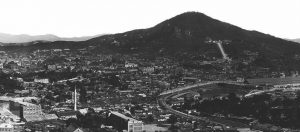
Download
Veranstaltungsort
Deutsches Institut für Japanstudien
Jochi Kioizaka Bldg. 2F
7-1 Kioicho, Chiyoda-ku
Tokyo 102-0094, Japan
Anmeldung
The DIJ History and Humanities Study Group is a forum open to scholars working on Japan in any field of the humanities. It is organized by Ronald Saladin and Torsten Weber.
All are welcome to attend, but prior registration (![]() weber@dijtokyo.org) is greatly appreciated.
weber@dijtokyo.org) is greatly appreciated.
Seoul's Namsan under Japanese Influence - Japanese Ritual Life and Assimilation Policy in Korea, 1890-1945
25. Mai 2017 / 18:30
Namsan is a small mountain in central Seoul. It was used for propaganda both by the Japanese who settled there in the 1890s and by Koreans until the democratization of South Korea in the 1980s. However, as Namsan nowadays has become a famous leisure attraction for tourists as well as locals, the fact that it has a troubled and politically charged history is mostly forgotten.
This talk outlines the changes on Namsan around the period of Japanese rule. During that time, Shintō shrines and Buddhist temples were continuously built on and around Namsan, turning it into the center of Japanese ritual life. At the same time, by removing traditional Korean ritual sites, Koreans were estranged from their own spiritual traditions. From 1925, when the Japanese Government and the Government-General of Chōsen decided to build Chōsen Jingū on Namsan, the issue of Koreans visiting Namsan and taking part in Japanese ritual life became even more politicized. As a result, Namsan was slowly turned into a space of assimilation of Koreans into Japanese – a development that reached its pinnacle when Koreans were forced to pray at shrines during the wartime years.
Understanding Namsan as a locale where Japanese and Korean history intertwine, this talk will focus on two aspects. First, the relationship of shrines and temples on Namsan will be scrutinized in order to show how a refined „ritual system“ was built on Namsan. Secondly, it will be asked what the Japanese takeover of Namsan meant to Koreans and how they reacted to the participation in Japanese ritual life. The main argument is that Shintō and Buddhist sites on Namsan where used to not only to teach Koreans about Japan and about the Japanese way of life, but the rituals themselves were used to incorporate Koreans into Japanese ritual life in an effort of assimilation even before „official“ assimilation policies set in after 1937.
Juljan Biontino is Assistant Professor in the Department of Liberal Arts and Sciences of Chiba University. He received his PhD in History Education from Seoul National University in 2016. His field of research is Korean Modern History, especially the periods of the opening of the ports (1876-1905) and of Japanese rule (1910-1945). A German edition of his doctoral dissertation will be published by Nomos in 2017. Among his publications are „Zwischen management of violence und „Kultureller Politik“: General Utsunomiya Tarôs Rolle und kolonialpolitische Konzeptionen in Korea während der Niederschlagung der Bewegung vom 1. März 1919“ [Between management of violence and cultural politics: The role of General Utsunomiya Tarô and colonial conceptions in Korea during the supression of the March First Movement] (Bochumer Jahrbuch zur Ostasienforschung 34, 2011) and „Die Entstehung und Entwicklung der modernen Geschichtswissenschaft in Korea“ [The origins and development of modern historiography in Korea] (Zeitschrift für Geschichtswissenschaft, Feb. 2015).